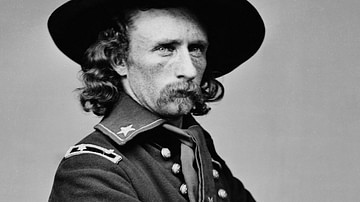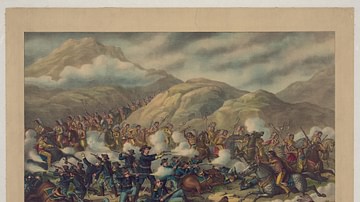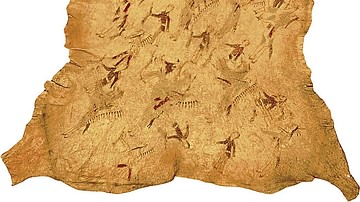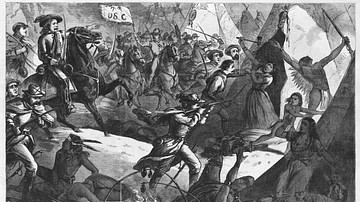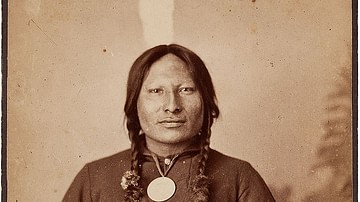Red Horse (Tasunka Luta, l. c. 1822-1907) was a chief of the Miniconjou Lakota Sioux best known for his firsthand account of the Battle of the Little Bighorn (25-26 June 1876) and his 42 ledger book drawings depicting the engagement. The account was given in 1881, the same year that Red Horse drew the images, which were rediscovered in 2016.

Little is known of Red Horse outside of his participation in the Battle of the Little Bighorn. He was a subchief, married twice, and had three children. In his accounts of the battle (there is another beside the one given below), his focus is on the event itself, not his participation in it, although he makes clear that he was in the thick of the fight. In 1881, Dr. Charles E. McChesney of the Smithsonian Bureau of Ethnology commissioned a study of Native American sign language and art ("picture-writing") which inspired the drawings of Red Horse and his account of the battle, which he gave using sign language which was then translated to English.
The best-known version of the account was published by Garrick Mallery in Picture Writing of the American Indians (1893) along with copies of some of the drawings, but these were not seen by many outside of the Bureau of American Ethnology, and the original artwork was sent to the Smithsonian Institution's National Anthropological Archives where they were carefully stored in drawers and forgotten, until Professor Scott D. Sagan of Stanford University, California, and his research assistant Sarah Sadlier (a Miniconjou Sioux) brought them to light in 2016 when they were featured in the exhibit, Red Horse: Drawings of the Battle of the Little Bighorn, at the Cantor Arts Center, California.
Today, the ledger drawings and account are more widely known and, like the Cheyenne and Arapaho description of the Battle of the Little Bighorn and Washita Massacre, Yellow Hair: George Armstrong Custer, present the Native American view of the battle and the wider conflict known as the Indian Wars of the mid- to late 19th century.
Background & Red Horse's Account
The Battle of the Little Bighorn is the best-known engagement of the Great Sioux War (1876-1877) and among the most famous in American history. Lt. Colonel George Armstrong Custer (l. 1839-1876), leading the 7th Cavalry, met the combined forces of Sioux, Cheyenne, and Arapaho, gathered by the Sioux chief Sitting Bull (l. c. 1837-1890), near the Little Bighorn River in modern-day Montana. Custer and five divisions of the 7th cavalry were wiped out, and the US government retaliated by pursuing the bands of the Plains Indians, eventually pushing them onto reservations.
The battle was presented in the US press of the time as "the massacre of our troops", as though the 7th cavalry had been out for a jaunt one day when they were suddenly attacked and killed by "savages" for no reason. Actually, the Sioux, Cheyenne, Arapaho, and other nations had been trying to negotiate peaceful relations with the Euro-Americans since the Fort Laramie Treaty of 1851. This treaty was never honored by the United States, and neither were the others, including the Medicine Lodge Treaty of 1867 and the Fort Laramie Treaty of 1868. Westward expansion in the name of Manifest Destiny would not be paused just because the Plains Indians had been living on the land long before the first Europeans reached North America.

Sitting Bull called for the great gathering at the Little Bighorn (known to the Natives as the Greasy Grass, and so their name for the conflict is the Battle of the Greasy Grass) to hold council with the other chiefs and try to find a way to defend their lands from the ongoing invasion. Custer had been sent to find their camp, kill the warriors, and capture the women and children to be held as hostages.
Although he had been warned by his Native American scouts that Sitting Bull's camp was larger – and had more warriors – than anyone had expected, Custer ignored them. He divided his troops to surround the camp – as he had successfully done at the Washita Massacre – and launched the attack, which would result in his death and those of five divisions of his cavalry.
Red Horse's account does not touch on any of these details but focuses on the battle itself. The details he includes match those of other Native American reports later given on the chaos of the conflict, including the one by the Sioux warrior Rain-in-the-Face (l. c. 1835-1905) and the one by the Oglala Sioux medicine man Black Elk (l. 1863-1950) given as Black Elk on the Battle of the Little Bighorn from Black Elk Speaks. Although Red Horse mentions Custer in his account, most of the reports make clear that no one knew Custer was on the field that day owing to the cavalry's swift attack and the dust raised by the horses.
Accompanying Red Horse's account were the 42 ledger book drawings of the battle depicting casualties on both sides, hand-to-hand combat, and each side leaving the field. Ledger art was drawings or paintings done on cloth or paper used in ledgers and was adopted by the Plains Indians in the 1860s. Previously, Native Americans of the region used hides (primarily of buffalo) for their art, but, as the US government systematically exterminated the buffalo herds to deprive the Plains Indians of their major food source, the animals became scarce, and so cloth or paper were used as canvas.
Ledger art of the Plains Indians depicts many aspects of everyday life including courtship rituals and hunting parties but primarily focuses on battles. The artist was always careful to depict the events in detail and so, as in the case of Red Horse's work, one can tell who the people are, what nation or band the warriors belonged to, and even, roughly, the locale and terrain. Taken together, Red Horse's account and artwork present one of the most interesting depictions of the Battle of the Little Bighorn extant.
Text
The following text is taken from Picture Writing of the American Indians, Volume I (1893) by Garrick Mallery, republished by Dover Publications in 2012.
Five springs ago I, with many Sioux Indians, took down and packed up our tipis and moved from Cheyenne River to the Rosebud River, where we camped a few days; then took down and packed up our lodges and moved to the Little Bighorn River and pitched our lodges with the large camp of Sioux.
The Sioux were camped on the Little Bighorn River as follows: The lodges of the Uncpapas were pitched highest up the river under a bluff. The Santee lodges were pitched next. The Ogallala's lodges were pitched next. The Brule lodges were pitched next. The Miniconjou lodges were pitched next. The Sans Arcs' lodges were pitched next. The Blackfeet lodges were pitched next. The Cheyenne lodges were pitched next. A few Arikara Indians were among the Sioux (being without lodges of their own). Two-Kettles, among the other Sioux (without lodges).
I was a Sioux chief in the council lodge. My lodge was pitched in the center of the camp. The day of the attack I and four women were a short distance from the camp digging wild turnips. Suddenly one of the women attracted my attention to a cloud of dust rising a short distance from camp. I soon saw that the soldiers were charging the camp. To the camp I and the women ran. When I arrived, a person told me to hurry to the council lodge. The soldiers charged so quickly we could not talk (council). We came out of the council lodge and talked in all directions. The Sioux mount horses, take guns, and go fight the soldiers. Women and children mount horses and go, meaning to get out of the way.
Among the soldiers was an officer who rode a horse with four white feet. [This officer was evidently Capt. French, Seventh Cavalry.] The Sioux have for a long time fought many brave men of different people, but the Sioux say this officer was the bravest man they had ever fought. I don't know whether this was Gen. Custer or not. Many of the Sioux men that I hear talking tell me it was. I saw this officer in the fight many times but did not see his body. It has been told me that he was killed by a Santee Indian, who took his horse. This officer wore a large-brimmed hat and a deerskin coat. This officer saved the lives of many soldiers by turning his horse and covering the retreat. Sioux say this officer was the bravest man they ever fought. I saw two officers looking alike, both having long yellowish hair.
Before the attack the Sioux were camped on the Rosebud River. Sioux moved down a river running into the Little Bighorn River, crossed the Little Bighorn River, and camped on its west bank.
This day [day of attack] a Sioux man started to go to Red Cloud agency, but when he had gone a short distance from camp, he saw a cloud of dust rising and turned back and said he thought a herd of buffalo was coming near the village.
The day was hot. In a short time, the soldiers charged the camp. [This was Maj. Reno's battalion of the Seventh Cavalry.] The soldiers came on the trail made by the Sioux camp in moving and crossed the Little Bighorn River above where the Sioux crossed, and attacked the lodges of the Uncpapas, farthest up the river. The women and children ran down the Little Bighorn River a short distance into a ravine. The soldiers set fire to the lodges. All the Sioux now charged the soldiers and drove them in confusion across the Little Bighorn River, which was very rapid, and several soldiers were drowned in it. On a hill the soldiers stopped, and the Sioux surrounded them. A Sioux man came and said that a different party of Soldiers had all the women and children prisoners. Like a whirlwind the word went around, and the Sioux all heard it and left the soldiers on the hill and went quickly to save the women and children.
From the hill that the soldiers were on to the place where the different soldiers [by this term Red Horse always means the battalion immediately commanded by General Custer, his mode of distinction being that they were a different body from that first encountered] were seen was level ground with the exception of a creek. Sioux thought the soldiers on the hill [i.e., Reno's battalion] would charge them in rear, but when they did not the Sioux thought the soldiers on the hill were out of cartridges. As soon as we had killed all the different soldiers the Sioux all went back to kill the soldiers on the hill. All the Sioux watched around the hill on which were the soldiers until a Sioux man came and said many walking soldiers were coming near. The coming of the walking soldiers was the saving of the soldiers on the hill. Sioux cannot fight the walking soldiers [infantry], being afraid of them, so the Sioux hurriedly left.
The soldiers charged the Sioux camp about noon. The soldiers were divided, one party charging right into the camp. After driving these soldiers across the river, the Sioux charged the different soldiers [i.e., Custer's] below, and drive them in confusion; these soldiers became foolish, many throwing away their guns and raising their hands, saying, "Sioux, pity us; take us prisoners." The Sioux did not take a single soldier prisoner, but killed all of them; none were left alive for even a few minutes. These different soldiers discharged their guns but little. I took a gun and two belts off two dead soldiers; out of one belt two cartridges were gone, out of the other five.
The Sioux took the guns and cartridges off the dead soldiers and went to the hill on which the soldiers were, surrounded and fought them with the guns and cartridges of the dead soldiers. Had the soldiers not divided I think they would have killed many Sioux. The different soldiers [i.e., Custer's battalion] that the Sioux killed made five brave stands. Once the Sioux charged right in the midst of the different soldiers and scattered them all, fighting among the soldiers hand to hand.
One band of soldiers was in rear of the Sioux. When this band of soldiers charged, the Sioux fell back, and the Sioux and the soldiers stood facing each other. Then all the Sioux became brave and charged the soldiers. The Sioux went but a short distance before they separated and surrounded the soldiers. I could see the officers riding in front of the soldiers and hear them shooting. Now the Sioux had many killed. The soldiers killed 136 and wounded 160 Sioux. The Sioux killed all these different soldiers in the ravine.
The soldiers charged the Sioux camp farthest up the river. A short time after the different soldiers charged the village below. While the different soldiers and Sioux were fighting together the Sioux chief said, "Sioux men, go watch soldiers on the hill and prevent their joining the different soldiers." The Sioux men took the clothing off the dead and dressed themselves in it. Among the soldiers were white men who were not soldiers. The Sioux dressed in the soldiers' and white men's clothing fought the soldiers on the hill.
The banks of the Little Bighorn River were high, and the Sioux killed many of the soldiers while crossing. The soldiers on the hill dug up the ground [i.e., made earthworks], and the soldiers and Sioux fought at long range, sometimes the Sioux charging close up. The fight continued at long range until a Sioux man saw the walking soldiers coming. When the walking soldiers came near, the Sioux became afraid and ran away.

